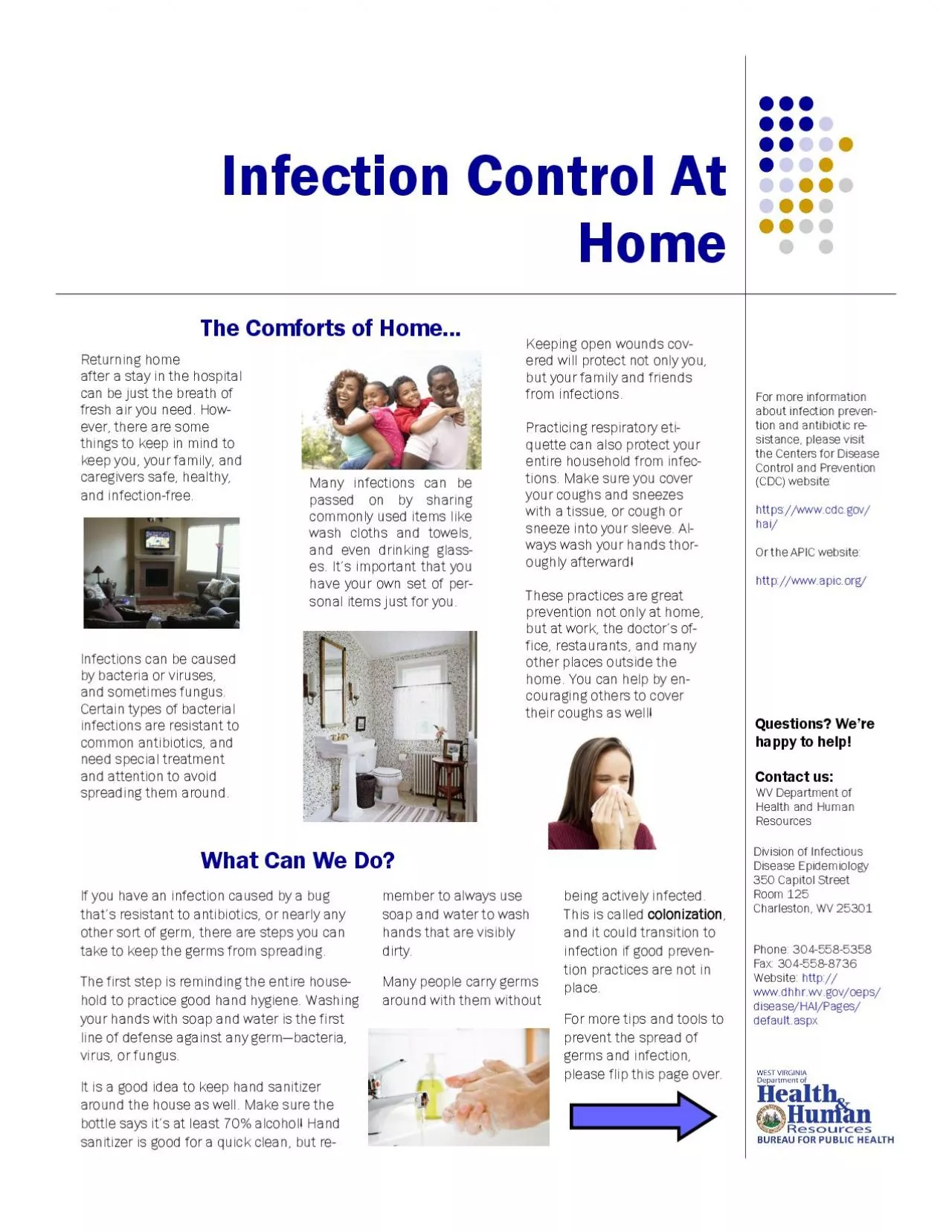

after a stay in the hospital can be just the breath of fresh air you need How ever there are some things to keep in mind to keep you your family and caregivers safe healthy and infection ID: 961586
Download Pdf The PPT/PDF document "Returning home" is the property of its rightful owner. Permission is granted to download and print the materials on this web site for personal, non-commercial use only, and to display it on your personal computer provided you do not modify the materials and that you retain all copyright notices contained in the materials. By downloading content from our website, you accept the terms of this agreement.
Returning home after a stay in the hospital can be just the breath of fresh air you need. How- ever, there are some things to keep in mind to keep you, your family, and caregivers safe, healthy, and infection - free. Many infections can be passed on by sharing commonly used items like wash cloths and towels, and even drinking glass- es. It’s important that you have your own set of per- sonal items just for you. The Comforts of Home... What Can We Do? If you have an infection caused by a bug that’s resistant to antibiotics, or nearly any other sort of germ, there are steps you can take to keep the germs from spreading. The first step is reminding the entire house- hold to practice good hand hygiene. Washing your hands with soap and water is the first line of defense against any germ — bacteria, virus, or fungus. It is a good idea to keep hand sanitizer around the house as well. Make sure the bottle says it’s at least 70% alcohol! Hand sanitizer is good for a quick clean, but re- member to always use soap and water to wash hands that are visibly dirty. Many people carry germs around with them without being actively infected. This is called colonization , and it could transition to infection if good preven- tion practices are not in place. For more tips and tools to prevent the spread of germs and infection, please flip this page over. Infection Control At Home Infections can be caused by bacteria or viruses, and sometimes fungus. Certain types of bacterial infections are resistant to common antibiotics, and need special treatment and attention to avoid spreading them around. Keeping open wounds cov- ered will protect not only you, but your family and friends from infections. Practicing respiratory eti- quette can also protect your entire household from infec- tions. Make sure you cover your coughs and sneezes with a tissue, or cough or sneeze into your sleeve. Al- ways wash your hands thor- oughly afterward! These practices are great prevention not only at home, but at work, the doctor’s of- fice, restaurants, and many other places outside the home. You can help by en- couraging others to cover their coughs as well! Division of Infectious Disease Epidemiology 350 Capitol Street Room 125 Charleston, WV 25301 Phone: 304 - 558 - 5358 Fax: 304 - 558 - 8736 Website: http:// www.dhhr.wv.gov/oeps/ disease/HAI/Pages/ default.aspx Questions? We’re happy to help! Contact us: WV Department of Health and Human Resources For more information about infection preven- tion and antibiotic re- sistance, please visi
t the Centers for Disease Control and Prevention (CDC) website: https://www.cdc.gov/ hai/ Or the APIC website: http://www.apic.org/ Household Cleaning Be sure to always wear utility gloves when cleaning, and wash your hands after taking them off! Clean tubs, sinks, showers, and countertops with a standard house- hold cleaning product. Clean toilets with a standard house- hold cleaning product. Mop floors at least once a week with a standard floor cleaner. Pour mop water down the toilet, not the sink. Clean the inside of the refrigerator weekly with a standard household cleaning product. Infection Prevention Tips... Laundry If laundry is visibly soiled: Put on disposable gloves, and dis- pose of any body substances. Flush liquid and semi - liquid substances down the toilet. Don’t shake soiled linens! If fabrics are severely soiled, presoak them in a standard laundry deter- gent. Dispose of presoaking water down the toilet. Wash clothes, linens, and/or towels that have been visibly soiled sepa- rately from the rest of the house- hold’s laundry. Do Not Share... These items are excellent vehicles for germs. Make sure you do not share: Razors Toothbrushes Enema equipment Drinking glasses Combs and hairbrushes Towels and washcloths Forks, spoons, knives, or cups during meals Any medical supplies Contaminated Wastes Before you begin, put on disposable gloves! Place all sharps into a puncture resistant container (an empty bleach bottle or laundry detergent bottle will work): Never recap a needle! Learn local rules for waste disposal: Con- tact your local health or sanitation de- partment. Place contaminated wastes in a plastic bag, and close tightly: Flush liquid and semi - liquid substances down the toilet: Needles Razor blades Broken glass Lancets Dressings Sanitary or incontinence pads Diapers Gloves used in patient care Blood Vomit Used facial tissues Urine Feces Remember to wash your hands with soap and water before and after you perform any medical task, such as giving medication, changing a dressing, or helping someone take a bath or shower or use the toilet. Wash your hands each time before you put on, and after you take off disposable gloves. Good hand hygiene is the number one way to prevent the spread of infection in your home and in your com- munity. Never touch any body substance with your bare hands — but if it should happen, always wash your hands thoroughly with soap and water